Home » Other Articles » Tuesday Treasures Index » Tuesday Treasures - September 2022 - Tuesday Treasures - September 2022
Tuesday Treasures - September 2022
TUESDAY 27 SEPTEMBER
Holidays by Train – Part 7
Our Holiday Season theme continues, with the illustrated small pamphlet self-proclaiming ‘GWR The Holiday Line’ dated 1921 in which it seized the opportunity offered by an ‘Indian Summer’ to push travellers to think holiday even though Autumn was imminent.
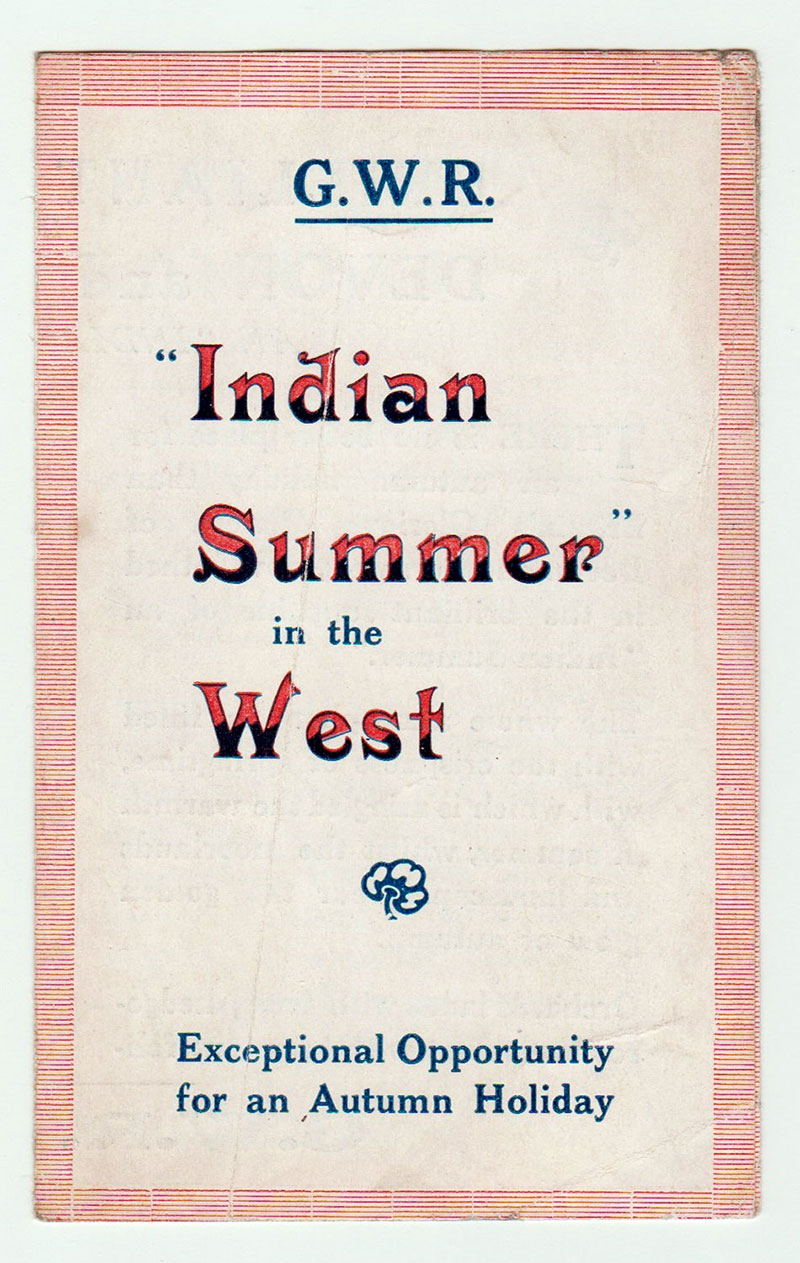
The pamphlet itself, on thin paper, is only 3 inches wide x 5 inches high, with 4 sides, but packs great detail in so small a space. We assume its size made it cheap to produce and a handy insert into a gentleman’s suit pocket for later study. Quite how the Great Western Trust collection has this example and an almost identical one of 1928, is pure fortunate fate it seems, as both were saved by an ex GWR/BRWR employee who had worked in their Publicity Department offices at Paddington. Both examples being Company reference copies.
As to the ‘Indian Summer’ title, this reflects British Empire associations, in that during that era, a vast number of British diplomatic and other staffs served long periods in India, and it was a fact of that continent's climate that our cooler, wetter September and October in the UK, generally coincided with to UK sensitivities, a pleasantly warm and drier period in India. That in 1921 and it seems in 1928, the UK itself had such an extended and pleasant warm and dry period, it was quite natural it seems to refer to it as ‘An Indian Summer’.
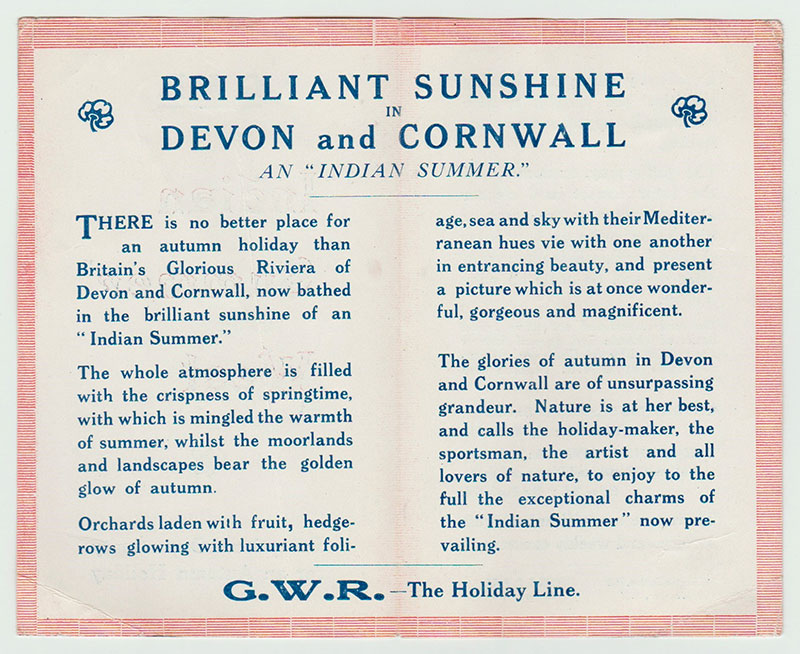
The illustrated centre spread, is very gushing in its description of the weather accentuating the well established delights on offer in Devon & Cornwall and yet again, it reflects the social strata of that age in that only the reasonably well off could even ponder an extended holiday, and on the back page this is really forced home by mention of “excellent yachting …and unrivalled opportunities for fishing”. To cap that message it concludes by stating:
“The golfer may on account of the later sunset and clearer atmosphere, play a game of his election quite an hour later than in London, indeed a round after tea will be quite an easy matter”…
Its final reminder is hardly surprising “There are magnificent express services and weekly excursions”
Around 100 years ago, such pamphlets, extolling the GWR as The Holiday Line to such attractive places during an Indian Summer provides us today with a glimpse of a transport company confident in its clientele and its reputation.
TUESDAY 20 SEPTEMBER
The Soil Mechanics Laboratory
One of the lesser known departments of the BR (Western Region) Chief Civil Engineer’s Office was the Soil Mechanics Laboratory.

Interior of the soil mechanics laboratory
Soil Mechanics is the study of the mechanical and physical properties of the soil and their application to engineering practice, such as the prediction of soil behaviour under loads imposed upon it and the analysis of the causes of any movement which may occur.
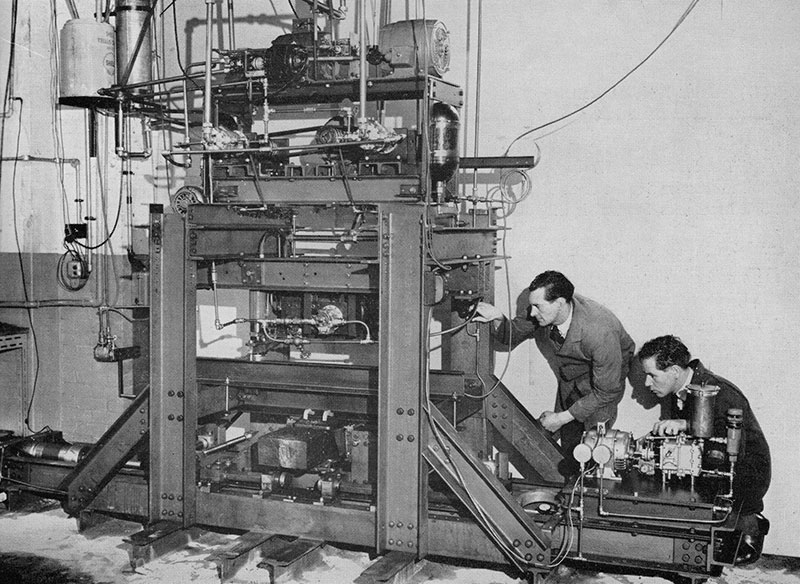
Dynamic testing of track fastenings
In 1942 a Soil Mechanics Section was established whilst the GWR war time headquarters were at Aldermaston. Post-war, the Section moved to Westbourne Terrace near Paddington Station and in 1953 to the basement of 66 Porchester Road near Royal Oak Station.
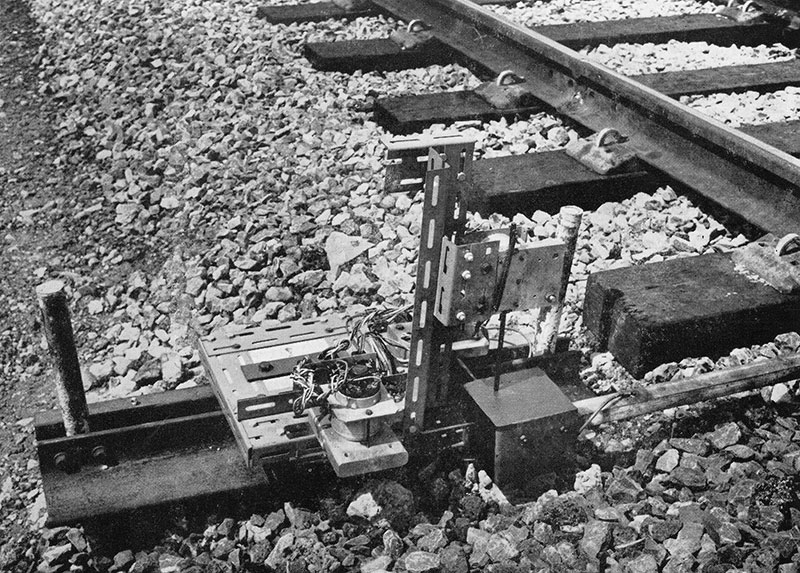
A welded rail recording station with cover removed
At this time the Section was much involved with the introduction of long welded rails and their expertise was used to investigate a number of factors, including resistance to buckling with various types of fastenings to sleepers, resistance to movement of sleepers in the ballast and the torsional resistance of the rail.
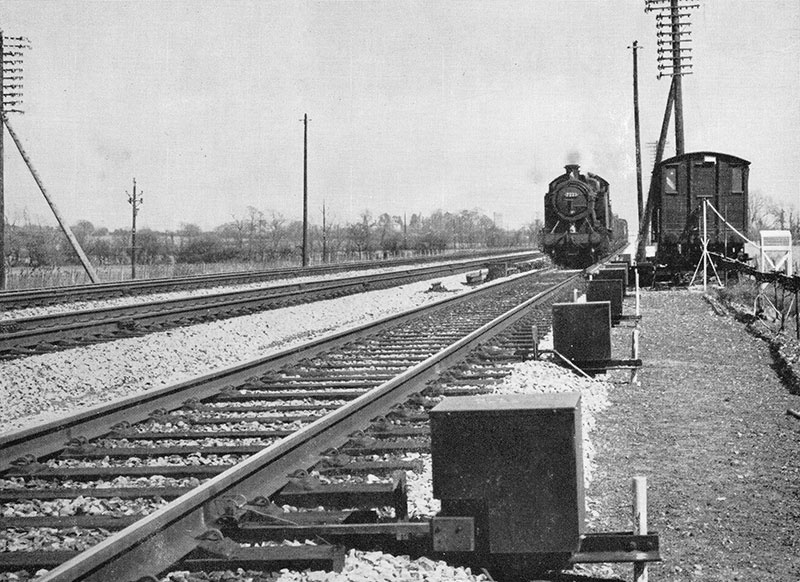
A welded rail recording station with the recording van in the siding on the right. No 7233, a heavy 2-8-2 tank locomotive is approaching and will no doubt provide an effective test of the track
Modern technology uses computer simulations which can (mostly) predict how materials will behave under certain conditions. The equipment in use in the 1950s may look crude to our eyes but it was effective and helped contemporary engineers to develop new techniques.
At selected stations along the lengths of welded track, recording instruments were set up at the side of the track. A light metal cube was attached to an arm clipped to the base of the rail; any movement of the rail was registered by push rods bearing on the faces of the cube. Push rods operated by receiver repeater motors in the Recording Van carried ball point pens which charted a continuous record of the movement on a strip chart drawn under the pens.
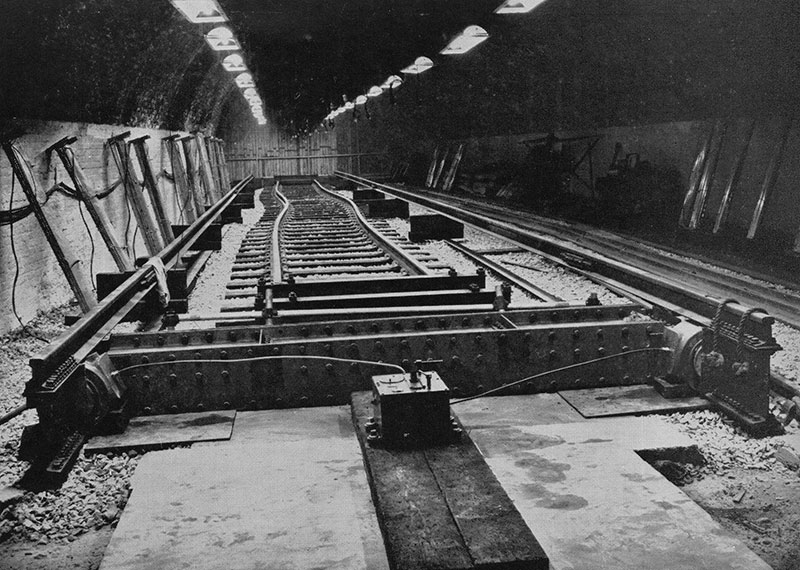
A buckling test in the disused tunnel near Westbourne Park
Buckling resistance of track was carried out in a disused tunnel at Westbourne Park which once gave access to the original locomotive depot at that place.
The above is just a precis from a wealth of information contained in the 30-page booklet, part of the Great Western Trust collection.
TUESDAY 13 SEPTEMBER
A Royal Commemoration
In a number of our previous blogs, we have reflected upon the vital connection between the GWR’s self-proclaimed “Royal Road” credentials based upon their being the first to transport the reigning British monarch, Queen Victoria. Thereafter, a vast number of Royal Train journeys were operated upon the GWR on both happy and sad occasions, the latter of course being Royal funerals.
Today, the death of Queen Elizabeth II after her 70 year extraordinarily long and transformative reign, will not involve our current railway companies in the massive undertaking of a funeral train to Windsor.
However, we mark the occasion with we consider an appropriate illustration from our Great Western Trust archive, of the decorative cover and editorial page of the June 1953 edition of the BRWR Staff Magazine, which, of its time, demonstrated the happiness, hope and acclamation then felt across the BRWR and BR staff as a whole at her Coronation.
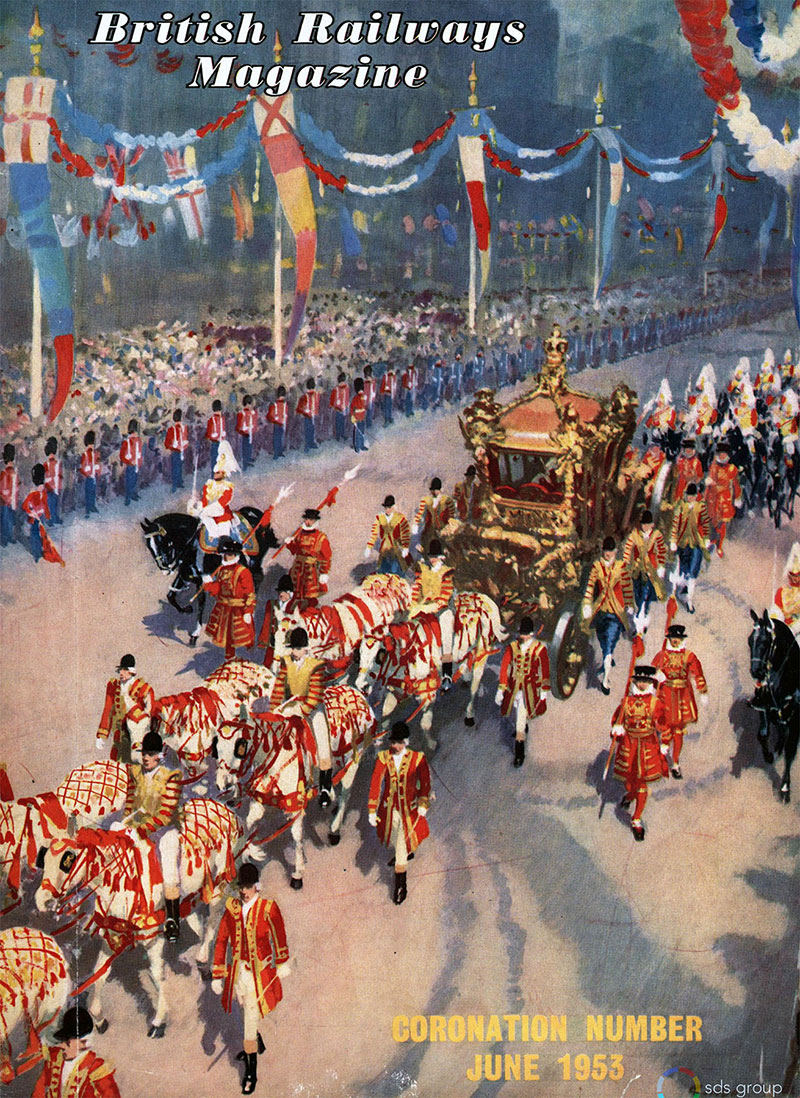
Most illuminating is that Editorial, worthy of close study, both for its chosen words of hope for the new Queen’s reign and its length, most amazingly fulfilled and that it is framed with vignette sketches of the evolution of railway travel in the time spans of the monarchs that had reigned since.
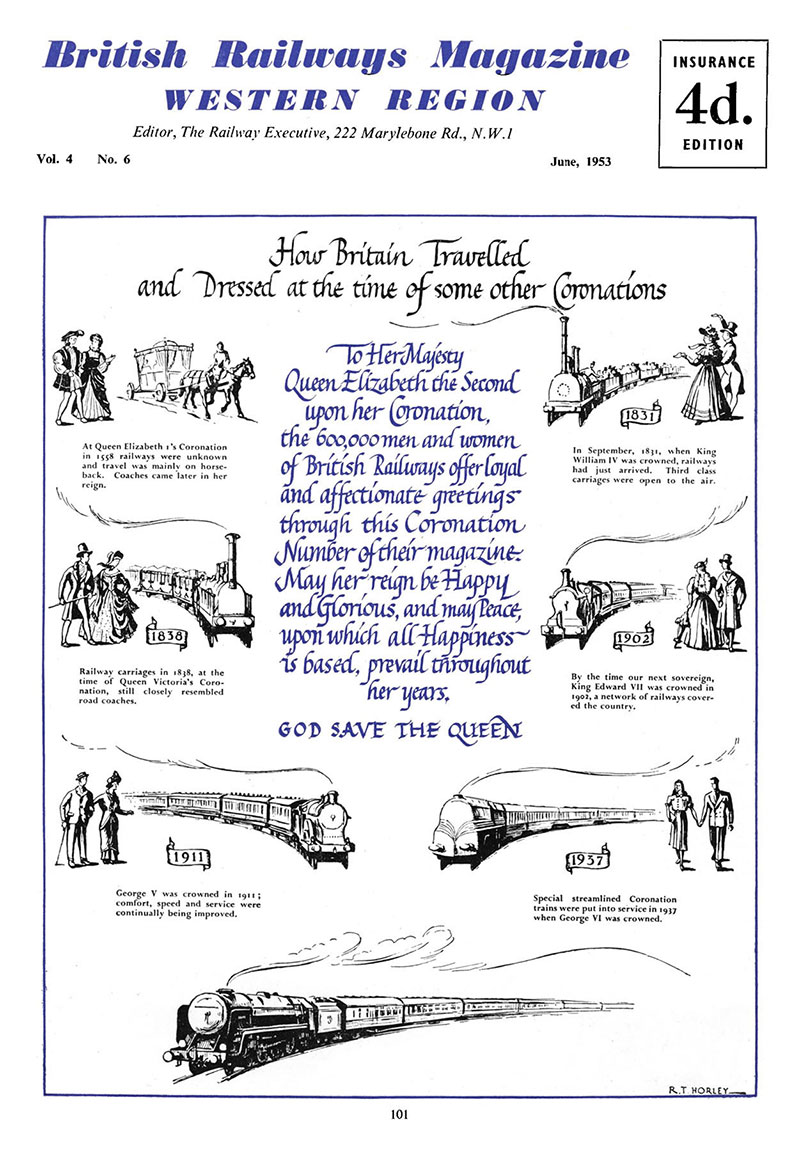
Whilst sadly the pinnacle of GWR express locomotives, justly adorned with King names, having reflected that of King George VI, we will not see a King Class loco named King Charles III.
May Queen Elizabeth II Rest in Peace, with our grateful thanks for her life well-lived and her unrivalled example to us all of service and duty.
TUESDAY 6 SEPTEMBER
St Giles' Fair, Oxford
As this handbill that we illustrate from our Great Western Trust collection explains, this Fair is probably the oldest ‘Pleasure Fair’ (as compared to market events) in the United Kingdom, with records dating back to the 12th century. Another title for it even into Victorian times, was a ‘Wake’.
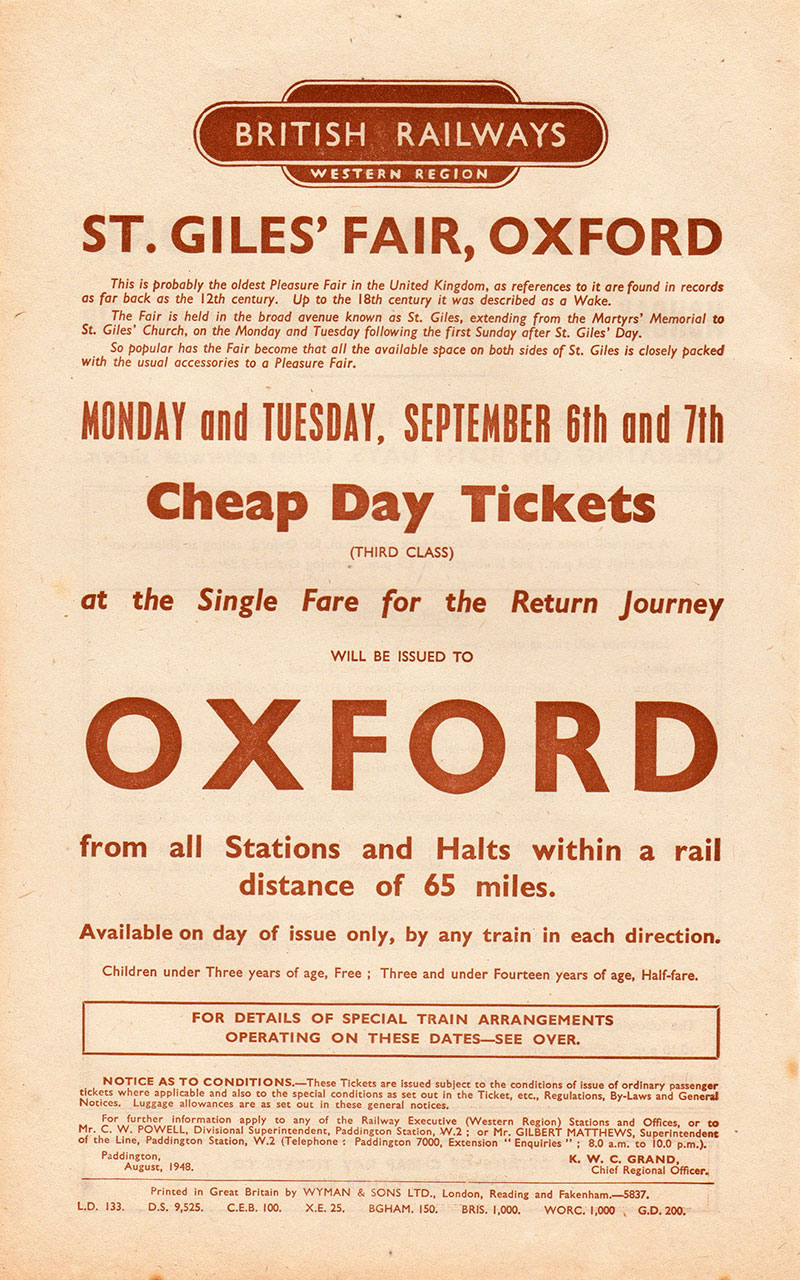
We celebrate it still at this time of year, marking the Monday and Tuesday after the first Sunday after St Giles' day in early September. It is held in the St Giles' street of Oxford, from the Martyrs' Memorial to St Giles' Church.
Being a very local event of such historic importance and longevity, recurring this very week, we felt a BRWR handbill would add to the evidence that even the railway recognised that local passenger traffic opportunities and demand deserved special services, and surprisingly perhaps, those were granted for stations up to 65 miles distant!
The extent of them is given on the reverse side which we also illustrate and here we can note that even the ‘Halts’ were granted special status!
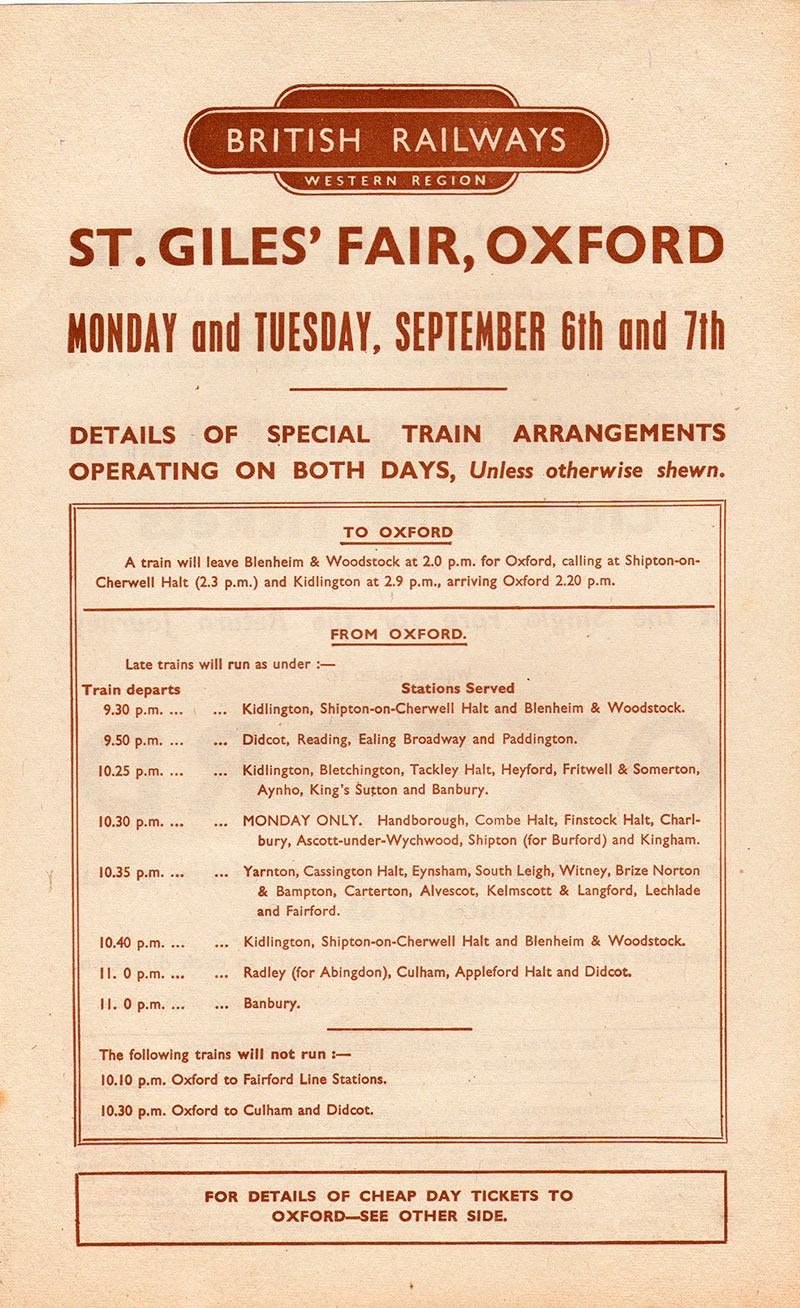
This handbill, itself another very rare survivor, dates from August 1948, and its footnote detail surprisingly shows that 150 copies were sent to Bristol and 1,000 each to Worcester and Birmingham. We do have a GWR example for special trains from the Birmingham area of 1883 but quite when such special trains began and of course were withdrawn are a current mystery.
The earliest we know is a report in Berrow's Worcester Journal on 12 September 1857: ‘A cheap special train ran to Oxford from this city on Monday last on the Oxford, Worcester, and Wolverhampton Railway, and was tolerably well patronized by visitors to St. Giles' Fair.’

St Giles' Fair in 2006
In 1860 the Birmingham Daily Post carried adverts for a special train to St Giles' Fair, with tickets costing 7s 0d (35p) 1st class and 4s 0d (20p) in a ‘covered carriage’. Today's equivalent of these fares is £30 1st class and £17 in the covered carriage.
Jackson's Oxford Journal reported on 9 September 1899: ‘Excursion trains were run from Cardiff, Birmingham, Coventry, London, and all intermediate stations in connection with the Fair, the number of persons thus brought into the city being about 6,700.’
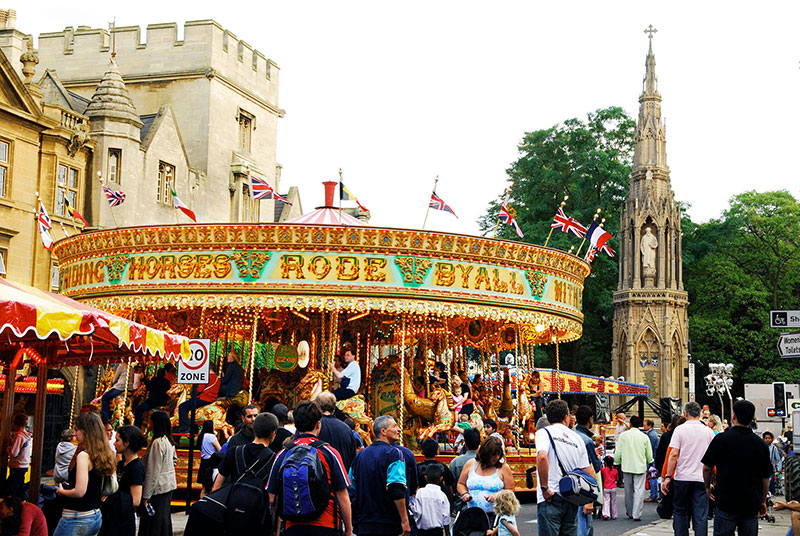
St Giles' Fair in 2006,. The Martyr's Memorial is visible on the right
For the stations and lines covered in this BRWR handbill, the closures of our many local branch lines and even stations on the main trunk routes, such as Kidlington, must have severely reduced the potential passenger demands.
Yet again, a simple handbill, even of BRWR era, proves the social history aspect of railway transport. A Fair of such communal importance, begun many centuries beforehand, still proved a transport service for a more modern era.
Didcot Railway Centre Newsletter
Stay up to date with events and what's going on at Didcot Railway Centre.
You may unsubscribe at any time. We do not share your data with 3rd parties.